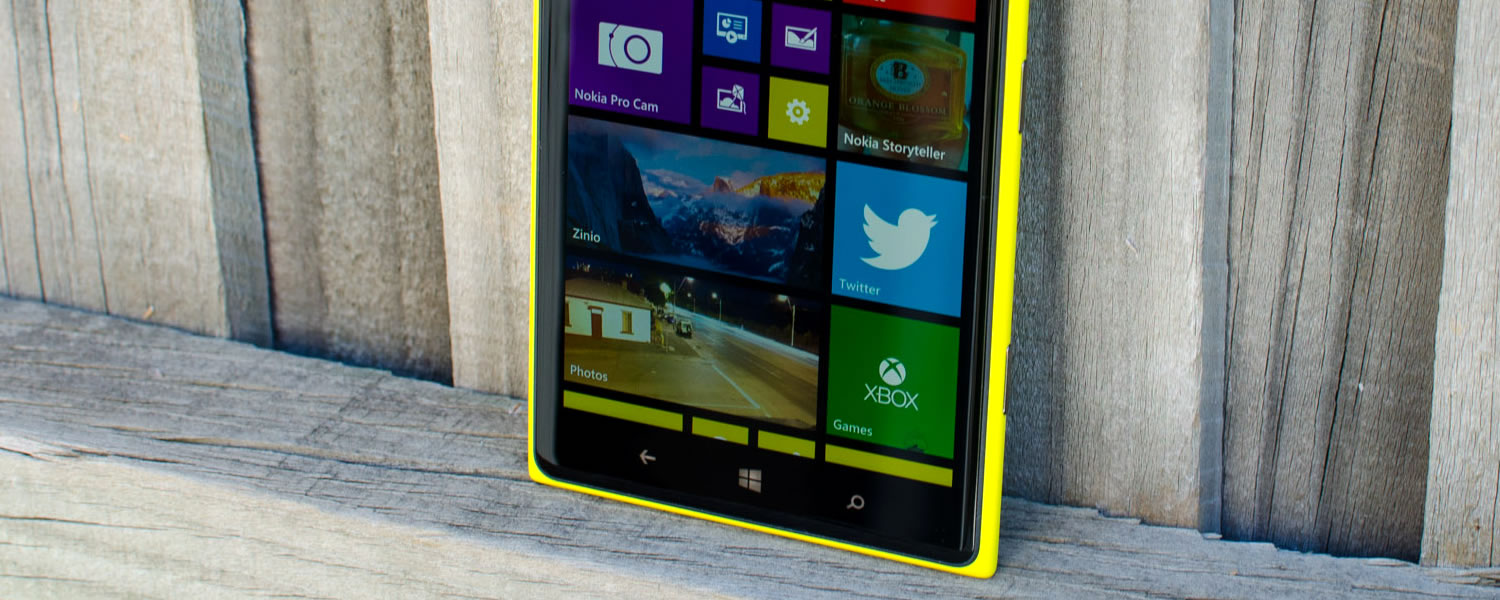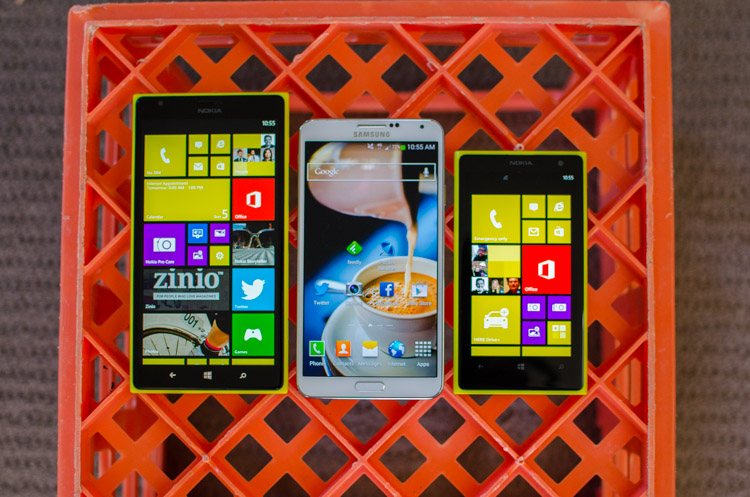Nokia had a busy 2013 gunning for every segment of the smartphone market. The now Microsoft-owned company took the low-end market by storm with the popular Lumia 520, while the Lumia 720 and Lumia 625 occupy the mid-range, and the Lumia 925 keeps the high-end in check. Let's not forget the Lumia 1020 either, whose monstrous 41-megapixel camera makes it the perfect smartphone for photography lovers.
Nokia Lumia 1520 - $699 (unlocked)
- 6.0", 1920x1080 IPS LCD (368 ppi)
- Qualcomm Snapdragon 800 SoC
- 2.3 GHz quad-core CPU, Adreno 330 GPU, 2GB RAM
- 32 GB internal storage, microSD card slot
- 20 MP camera, 1/2.5" sensor, f/2.4 lens, 1080p30 video
- 3,400 mAh, 12.9 Wh battery
- LTE, Wi-Fi a/b/g/n/ac, Bluetooth 4.0, NFC
- Windows Phone 8 Update 3
- 209 grams, 8.7mm thick
And yet there was another slice of the market that Nokia hadn't touched, until now. Throughout the past year we've seen companies try and pry the large-screen crown away from Samsung's Galaxy Note line, but the likes of the Sony Xperia Z Ultra and HTC One Max have failed to make a serious impact. Nokia is hoping that their Lumia 1520 will give the Note 3 a run for its money, especially with its impressive spec sheet.
The Lumia 1520 is the first Windows Phone to come with a Snapdragon 800 SoC, the first with a quad-core CPU, the first with a 1080p display, and the first to really compete on a hardware level with top Android devices of the same generation. It also sees Nokia's vast imaging expertise put to good use once again, with the inclusion of a 20-megapixel PureView shooter sure to please enthusiasts out there.
Chucking in all this top-end hardware isn't a simple key to success, though, as it has to be complemented by a well-integrated software suite. Will this flagship Windows Phone be able to deliver?
The Nokia Lumia 1520 used in this review was provided by Expansys. Check them out for unlocked, off-contract devices at great prices, with fast shipping around the globe.
Design
Packing a six-inch display into a smartphone is never going to make it small, so the challenge for any designer is keeping it portable. The Galaxy Note 3 is large but it never feels restrictive, whereas the Xperia Z Ultra and its 6.4-inch display felt cumbersome and affected usability. The Lumia 1520 fits somewhere in between: it'll take large pants pockets to accommodate the device's footprint, but the display always feels manageable.
The largeness factor is soothed by good ergonomic choices that don't affect the handset's looks. The edges of the 1520 are curved to perfection, and the display's Gorilla Glass protection also glides away to either side, making it remarkably easy to manipulate content on-screen. Despite the 1520's curves, it still looks like a device that's made for today's market, featuring a squarish body that complements Windows Phone 8 and reasonably small bezels.
Speaking of bezels, the six-inch display is buffered by 5mm to either side and 19mm to the top and bottom. The display occupies around 71% of the front panel, which is reasonable but not quite as bezel-slim as the Note 3, which sees 75% display coverage. Nokia claims the device is 8.7mm thick, but my measurements place it closer to 9.3mm thick, rising to 10.8mm at the camera hump; regardless of Nokia's measurement error, the Lumia 1520 feels slim in your hands.
Once again Nokia has chosen soft-touch polycarbonate for the majority of the Lumia 1520's construction, giving it a very similar feel to the mid-range Lumia 720. While the polycarbonate material used is technically plastic, it shows that Nokia knows its hardware as the phone retains a high-class, high-quality feel to it. The 1520's back panel is reasonably smooth, but it feels great, avoiding the same issues we've come to see time and again from Samsung's cheap plastic crusade.
The polycarbonate unibody is available in four colors: you can get a standard black or white, or for the adventurous there's also red and yellow. As you can tell from our review photos, we got the yellow model and it's quite striking. Deeply infused into the plastic, the color is high quality and will surely turn heads whenever you pull out the device from your pockets, especially considering the size of the phone itself.
Around the device you'll find the 3.5mm audio jack in the middle of the top edge, the microUSB port in the middle of the bottom edge, and the usual configuration of buttons on the right-hand side. The volume rocker sits at the top, followed by the power button, which is placed in a remarkably comfortable position considering the size of the Lumia 1520. Further down you'll find the two-stage camera button, a staple inclusion on all Windows Phones that assists captures taken with the 20-megapixel rear shooter.
On the top left-hand edge you'll find both the microSD card slot and SIM card slot neatly tucked into the unibody. With a press of the SIM removal tool, either one of the trays can be removed entirely, assisting in the procedure of placing the necessary cards inside the device. Interestingly Nokia has gone for a less common nano-SIM in the 1520, which could mean you'll have to change over your SIM if you're coming from any phone other than an iPhone.
I'm glad to see the resurgence of the microSD card slot in Nokia's smartphones, because at one point the company capped the internal storage at 16 GB, removed the microSD option and thought that would be acceptable.
Apart from the massive display, the front panel is a typical Nokia affair: understated and functional. The buttons at the bottom of the screen are quite far down the handset's profile and the back button can be hard to hit, but it's something that is bound to become more natural after a few weeks of use. Above the display you'll find the call speaker, a front-facing camera and a few hidden sensors.
The back is very understated (except for the yellow, of course). There's a reasonable hump to accommodate the large camera sensor, plus a dual-LED flash, a few bits of branding and a speaker grille at the bottom. The body exhibits a small amount of flex when you attempt to bend it, but it's nothing to be overly concerned about.
Display
The Nokia Lumia 1520 brings us the first Windows Phone with a truly high-resolution display. Hardware wise we're seeing a 6-inch IPS TFT LCD panel with a resolution of 1920 x 1080, coming with a pixel density of 367 PPI and over 99.2 square centimeters of real estate. Microsoft had to put in some work to get the resolution supported in Windows Phone 8 GDR3, but the work has certainly paid off.
The Lumia 1520's display is large and beautiful, easily beating Nokia's smartphones of the past, such as the Lumia 925 and Lumia 1020, which utilized 1280 x 768 AMOLED panels. The display exhibits great color reproduction, balanced across the range yet with enough vibrancy to make any image look fantastic. In the settings menu you can adjust the color profile of the display to your liking, but I tend to find the default settings provide a great balance between saturation and lifelikeness.
Contrast from the IPS display is great as far as LCDs are concerned, but not as strong as AMOLEDS due to some of the backlight passing through. Looking at standard display test patterns reveals the Lumia 1520's panel can display all but three of the deepest black levels, and all of the white levels. There's slight banding when looking at gradients, meaning it falls behind the displays that LG uses in the G2 and Nexus 5, but it's nevertheless high quality.
The display's 1080p resolution is also a first in terms of aspect ratio, with all other Lumias until this point using 15:9 panels rather than 16:9. The aspect ratio is of little consequence, but the resolution is not, making everything from text to videos look simply superb. Where edges look competitively blurry on the Lumia 1020's PenTile AMOLED, they look sharp and defined on the Lumia 1520's.
This form of hardware anti-aliasing is most pronounced when viewing text, as fonts can get thinner and smaller without losing the ability to actually read them. 367 PPI isn't as dense as you'll get from a 4.7-inch or 5.0-inch 1080p display that can go as high as 400 PPI, but you'll likely view the 1520's large display from further away, giving it the same paper-like quality of smaller handsets.
Nokia has integrated ClearBlack technology into the 1520's six-inch display, which is essentially a series of polarizing filters built into the panel that reject ambient light, making it easier to see the display when outdoors. Combined with sunlight readability enhancements on the software side, the 1520's LCD panel is one of the easiest to see outdoors, keeping just as bright and easy to see in direct sunlight as indoors. It's also great to see that, despite the inclusion of polarizing filters, the display is readable while wearing polarizing sunglasses, albeit with a slight color shift depending on how you're viewing the display.
Strong viewing angles keep this particular IPS LCD readable at nearly all off-angles, including extremely acute ones, in a similar fashion to HTC's Super LCD 3 display used on the HTC One. Slight color shift occurs when viewing the display around 45 degrees, but it's hardly anything to be concerned about; it's still very easy to read the display when it's sitting on the desk, for example.
Unfortunately, the Lumia 1520 doesn't feature integrated stylus support like the Galaxy Note 3, which is something I'll explore in deeper detail in the software section (next page). It does however support high-sensitivity touch, so you can use the handset while wearing gloves. With high-sensitivity touch enabled it is possible to use a pencil or metal object as a 'stylus', but it's too hit and miss for me to recommend this as a serious stylus-enabled phone.
The 1520's display is easily the best I've seen on a Windows Phone and one of the most beautiful out of all the smartphones on the market beating both the Galaxy Note 3 and Xperia Z Ultra in overall quality by some margin.












